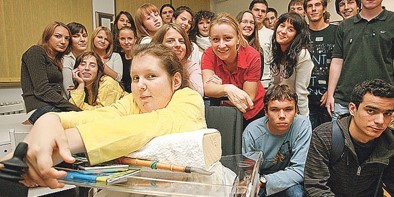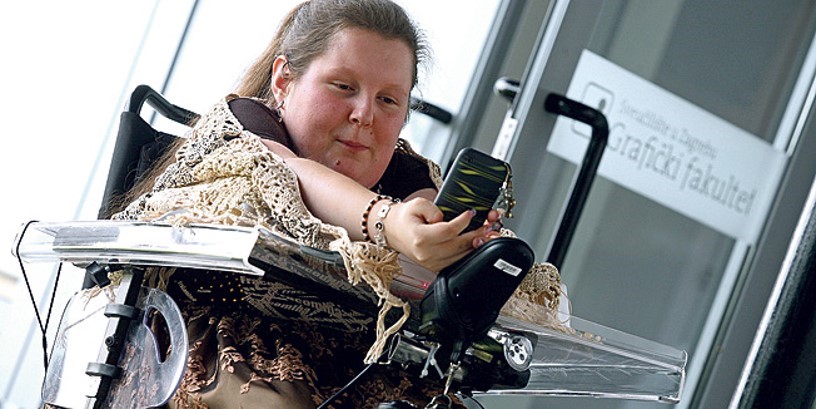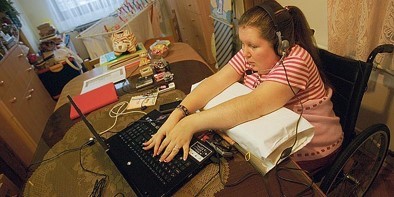Distance learning for learners with mobility disabilities
Jesenka Pibernik
University of Zagreb, Faculty of Graphic ArtsJesenka Pibernik
University of Zagreb, Faculty of Graphic ArtsThe case study describes the challenges of university-level distance learning for a student with a mobility disability. Virtual learning environment (VLE) principal components, curriculum planning and use of social media advice were given to overcome time and distance barriers. Also, the limitations we perceived in the process are explained. As a resource, collaborative software (Adobe Connect) which allows screen-sharing experience between the instructor and student with interactive content was presented.
Distance learning, mobility disability, virtual learning environment, screen-sharing experience
Studij slučaja opisuje izazove učenja na daljinu studentice s teškoćama u kretanju. Opisane su osnovne komponente virtualnog sustava za e-učenje, način planiranja kolegija i uporaba društvenih mreža kako bi se nadišle prostorno-vremenske barijere. Također, objašnjena su i ograničenja koje smo percipirali u procesu. Kao resurs, prezentiran je kolaborativni software Adobe Connect koji dozvoljava interaktivni doživljaj dijeljenja ekrana između instruktora i studenta.
Učenje na daljinu, teškoće u kretanju, virtualni sustav za e-učenje, doživljaj dijeljenja ekrana
As university teachers, we have faced a problem of teaching graphic design skills to a student LP who could not be physically present in the faculty building due to her mobility disability (Picture 1). The student had a personal assistant who had already mastered the same skills and helped with assignments. For other students in her class, we used a blended learning approach (Picture 2). It combined online educational materials and opportunities for interaction online with traditional place-based classroom methods.
Distance learning for learners with disabilities means student involvement in learning materials at home. As a pedagogical approach, it encompasses student-centered interactive instruction that can be synchronous and/or asynchronous. Distance learning can provide the learner with a great deal of experiential learning, extensive interaction with content, other learners, and the instructor, and can also counteract time and distance barriers. Even though, face-to-face meetings with tutors were occasionally arranged.

Picture 1. LP in the classroom with her classmates.
Q: “LP is a proving anything is possible when you have a strong spirit and right people to support you.”
Distance education requires a set of teaching and learning tools designed to enhance a student’s learning experience by including computers and the Internet in the learning process e.g. virtual learning environment (VLE). The principal components of a VLE package include curriculum mapping (breaking curriculum into sections that can be assigned and assessed), student tracking, online support for both teacher and student, electronic communication (e-mail, threaded discussions, chat, Web publishing), and Internet links to outside curriculum resources (https://global.oup.com/uk/orc/learnvle/). We used a specific VLE (Merlin) based on open source Moodle and available at our university free of charge.
Curriculum planning included interactive activities such as cooperation, assignments, assessment modes and required comments via correspondence. In Merlin, students can interact with course content (e.g., via traditional class notes, simulations, video review), hold synchronous and asynchronous discussions with each other and the instructor, complete and submit assignments, complete exams, check grades, and complete e-mail correspondence (Picture 2).
Curriculum planning included interactive activities such as cooperation, assignments, assessment modes and required comments via correspondence.
Hrastinski (2008) compared asynchronous and synchronous e-learning and found that in synchronous communication, it was possible to monitor the receiver’s reaction to a message, which therefore increases arousal and motivation in the learner. He concluded that synchronous e-learning better supported learners by providing them with social support.

Picture 2. The professor is talking to LP during regular class. He is using headphones and a laptop. Student LP is present online.
Instructors have to be flexible, innovative, and creative, as dealing with the distance learner presents challenges different from that of a traditional classroom. Since much of graphic design work is done on the computer, students are instructed to use complex graphics tools to manipulate text, images, animations, and color. This requires special skills/knowledge and therefore set of instruction on how to use graphic design software has to be prepared and delivered. For student LP we broke down the complex instruction content into more manageable pieces, so the student could gradually master more complex skills and tasks. Also, we created custom assignments that engage the student through interactivity and collaboration.

Picture 4. LP is using her mobile phone to communicate with her peers
A student was able to interact with the instructor and other students via communication software. This was accomplished through the use of social media site (in our case Facebook) which also served as a sort of online community development centers. Social media online spaces are informal and students already felt comfortable in their use. Interaction implied two-way communication between the instructor and student and among students as a group. It can also be used by students to reflect on practical experiences with peers and teachers. The degree to which the distance learning student is perceived as a real person and perceives others involved in the course as real is important. This is described as a social presence (Picture 3).
Q: “It is much easier for me when I can see what is going on in the lecture room and hear what professors are saying”
There are a few limitations we have perceived in the process. Distance learning curriculum and content development are highly demanding in terms of instructor’s time spent on the computer. While the use of asynchronous media is supported by findings that time lags between learning interactions facilitate deep information processing and integration, synchronous activities (e.g. telephone conversations; instant messaging; video conferencing) requires constant time coordination of all participants. Also, the learning environment might not be always effective to satisfy student’s social and emotional needs and communicate immediate support when needed (Picture 6).
One of the collaborative software solutions available to our faculty was Adobe Connect. It can be used for online training, demonstration, meetings and document sharing. Sessions can be recorded and downloaded for later usage. It can be used on different mobile devices such as tablets and mobile phones. Also, virtual rooms can be created and customized with personal content, layouts, identity, etc.
Q: “Adobe Connect empowers you to create exceptional digital training, webinar, and collaboration experiences. “
One on one training allowed screen-sharing experience between the instructor and student with interactive content. The instructor sees the identical screen as a student (and vice versa), but the instructor had additional user rights to create or modify screen content and track student performance.
https://www.adobe.com/products/adobeconnect.html
There are online providers of learning materials and content creation tools such as MERLOT. MERLOT is a community of staff, volunteers, and members who work together in various ways to provide users of OER (Open Educational Resource) teaching and learning materials with a wealth of services and functions that can enhance their instructional experience. Every effort has been made to make the MERLOT website accessible to users of assistive technologies. It has been developed with the intention for keyboard users and screen reader users with the horizontal menu navigation to have the best possible user experience. MERLOT has addressed many accessibility requirements in its implementation of the website.
https://www.merlot.org/merlot/index.htm

Picture 6. LP at home, working on her laptop computer, headphones on her ears
A disability which made her dependent on wheelchair did not stop her to become a student. Through Skype, Lana is taking consultation. Teaching assistant Josip Bota: “You have made a good choice on typography except for these lines and shapes – you have to try again“. Lana: “Ok, then. I will try to improve until the next consultation time”. This is a way Lana is taking classes from her second year of study. Since her muscles stiffen, she can move only her fingers. Despite the disability, she has graduated with a Bachelor degree and enrolled in the master program at the University of Zagreb, Faculty of Graphic Arts. Lana: “It is much easier when I can see what is going on in the classroom, what the professor is saying and asking…”.
For video connection and other help, Lana’s assistant is in charge. The assistants have been employed thanks to the Ministry of Education and civil association Zamisli. Irena Borozni: “Hi Lana. If she needs something in the student office or consultation with the professor – I take equipment in the cabinet room.“ Professors and assistant are willing to help, they come to her home for the exams or use Skype, but ….Lana: “There are no excuses. I am doing the same excesses as everybody else except that they can do it in teams: learn and interrogate with peers. I have to do everything alone, at home… Josip Bota: “ She is very good in graphic design. That was proven at the enrolment exam for the master program – she was second..” With good grades, Lana has time for hand work on her jewelry. Lana: “Happy, joyful, persistent… in my opinion, this is necessary to survive.” Without a doubt, this twenty-two-year-old will be successful after she finishes her studies. She is a living proof that limitations are imaginary and with the persistence, all the impediments could be overcome.
Bolest koja ju je prikovala za kolica nije ju spriječila da studira. Putem skypea Lana je na konzultacijama. Asistent Josip Bota: “Tipografiju ste isto dobro izabrali. Samo ove linije i što se tiče samih likova – to ćete još isprobati”. Lana: “Dobro, onda ću do idućeg tjedna, idućih vježbi i idućih konzultacija probat popraviti”. Tako od druge godine studija prati i predavanja. Može micati jedino prstima jer su joj gotovo svi mišići okoštali. Usprkos bolesti i nakon tri godine preddiplomskog upisala je i diplomski studij na Grafičkom fakultetu Sveučilišta u Zagrebu. Lana: “Puno mi je lakše bilo jer u bit vidim što se u dvorani događa, što profesori pričaju, što trže..”.
Za video vezu i drugu pomoć pri studiranju zadužena je Lanina asistentica koju joj je omogućilo Ministarstvo obrazovanja i udruga Zamisli. Irena Borozni:“Bok Lana. Ako treba otići u referadu, ako želi obaviti konzultacije sa profesorom – odnesem opremu u kabinet”. I profesori i asistenti su susretljivi, na ispite joj dolaze kući ili ih polaže putem skype-a ali….Lana: “Popuštanja nema. Radim sve isto kao i drugi, samo dosta drugih kolega može na faksu raditi nešto u paru, učiti u paru, ispitivat se; a ja to sve moram sama doma. Josip Bota: “Jako je dobra u grafičkom dizajnu što se i pokazalo na prijemnom ispitu za diplomski studij gdje je bila druga.” A uz same petice i četvorke, Lana ima vremena i za izradu Nakita. Lana: “Sretna, vesela, uporna… jer smatram da ne bi preživjela u ovom svijetu da nisam takva.” Nema sumnje da će ova dvadeset dvogodišnjakinja i nakon završetka fakulteta nizati uspjehe. Pravi je dokaz da ograničenja ne postoje i da se sa upornošću sve prepreke mogu svladati.
“The European Commission support for the production of this publication does not constitute an endorsement of the contents which reflects the views only of the authors, and the Commission cannot be held responsible for any use which may be made of the information contained therein.”

"The European Commission support for the production of this publication does not constitute an endorsement of the contents which reflects the views only of the authors, and the Commission cannot be held responsible for any use which may be made of the information contained therein."